Attainment Scotland Fund evaluation: implementation and impact report 2024
This report shares implementation and impact evaluation evidence since the Scottish Attainment Challenge (SAC) refresh in 2022, utilising quantitative evidence gathered via a SAC Local Authority Leads Survey 2024, and qualitative evidence gathered through national stakeholder interviews.
Section 4: Impact
This section considers the emerging impact evaluation evidence in relation to key impact evaluation questions under consideration[31]:
- To what extent did schools, local authorities and other stakeholders, including pupils, families and communities feel there had been progress towards achieving outcomes?
- To what extent did the fund contribute to an education system which encourages, reflects and values the breadth of achievements that contribute to improved outcomes for children and young people?
- To what extent did the fund contribute to a closing of the attainment gap between the most and least socio-economically disadvantaged children and young people, in line with the refreshed Scottish Attainment Challenge Mission?
- To what extent was culture and ethos based on educational equity embedded in the education system that promotes high aspirations and recognises broader achievement for all children and young people and their families?
This is the first impact evidence from the evaluation since the refresh of the Scottish Attainment Challenge in 2022. However, links to previously published evaluation findings from the initial Scottish Attainment Challenge (2015 – 2022) will be referenced where possible.
Perceptions of progress in contributing to closing the poverty-related attainment gap
Overall, the evidence points to positive perceptions of progress on a number of aspects. More specifically, the evidence considered indicates:
- As outlined in Figure 6 below, all respondents to the SAC Local Authority Leads Survey 2024 viewed ASF as contributing to closing the poverty-related attainment gap in line with core and plus stretch aims in their local authority. Eight respondents indicated this was to a great extent, and eighteen indicated this was to some extent.
- All respondents also viewed ASF as contributing towards achieving improved outcomes for children and young people affected by poverty. However, this was slightly less positively evaluated than assessments of progress towards contributing to closing the poverty-related attainment gap in line with core and plus stretch aims, with four respondents indicating this was to a great extent, and twenty-two indicating this was to some extent.
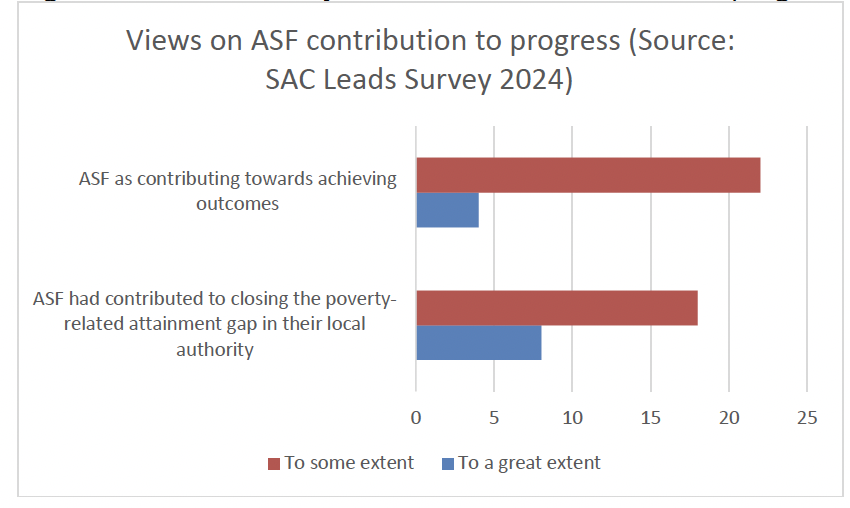
- Views on the extent to which specific ASF funding streams (Strategic Equity Funding, Pupil Equity Funding, Care Experienced Children and Young People Funding) were contributing towards progress were positive overall, with all respondents to the SAC Local Authority Leads Survey 2024 viewing this to be the case across all three funding streams.
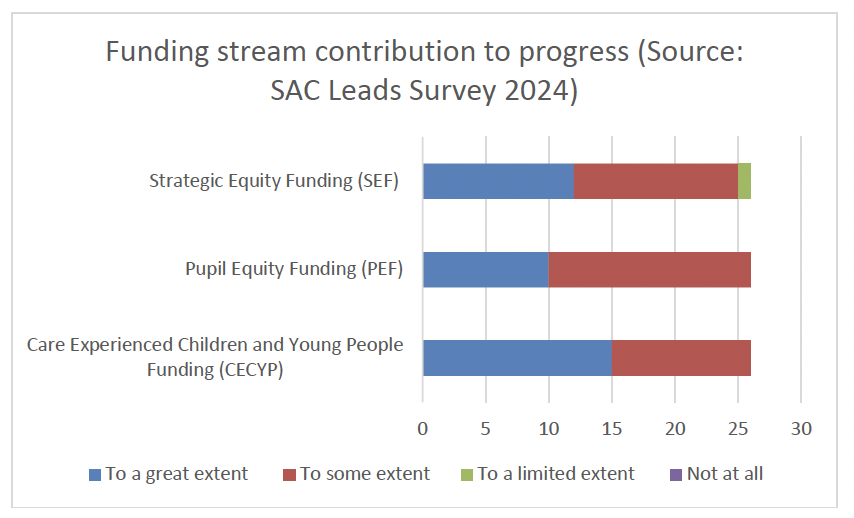
- Local authorities identified approaches based on Learning and Teaching as the underpinning ASF organiser contributing most to progress towards improved outcomes for children and young people affected by poverty in their local authority, and to a greater extent than Leadership and Families and Communities.
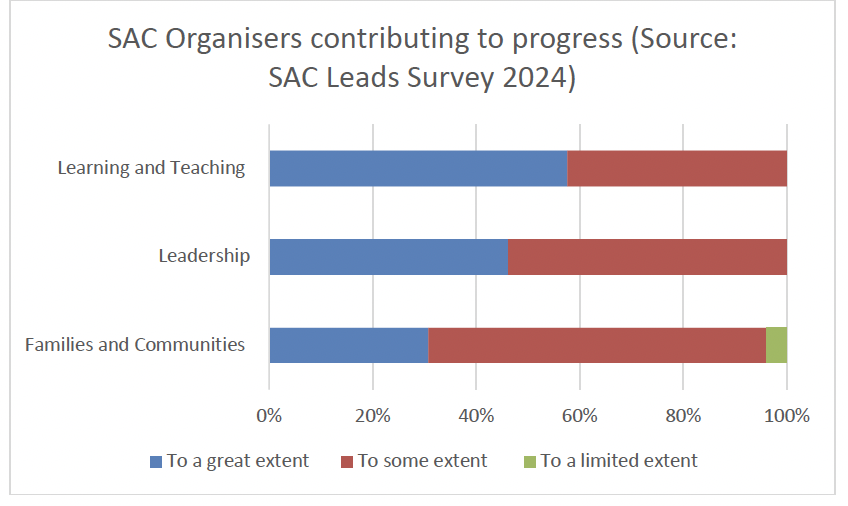
Factors supporting progress
A wide range of factors were identified in the SAC Local Authority Leads Survey 2024 as contributing to progress towards improving outcomes for children and young people affected by poverty in the local authority (see below for a summary of factors identified). These were broadly consistent with the findings of the initial evaluation prior to the refresh of SAC in 2022, and included:
- Collaboration;
- Effective use of data and evidence;
- Understanding of and increased awareness of poverty;
- Strategic planning and joined up approaches, including governance structures;
- Targeted support and use of ASF.
Addressing financial barriers, such as Cost of the School Day approaches, emerged as increasingly viewed as associated with progress, alongside the introduction of specific roles supported by ASF to address attendance and health and wellbeing.
Factors contributing to progress
- Effective use of data and evidence
- Strategic planning and joined up approaches
- Collaboration
- Increased awareness and understanding of poverty, and the actions which can be taken to mitigate effects of poverty
- Targeted support and targeted use of ASF funding
- Leadership
- Strategic central support and staffing
- Focus on Cost of the School Day
- Improved learning and teaching
- Professional learning
- Effective approaches to family learning
- Interventions based on school/local contexts
- Attainment Advisor support and challenge
- Sustained focus on numeracy and literacy and HWB
- Improved school improvement planning processes
- Increasingly skilled support staff, and input of non-teaching staff
- Culture of equity and empowerment
- Building capacity and capability
- Relationships and and participation between schools and families with supports in place at local level and partnerships between school and community, such as home link workers
- Additionality of funding to support building capacity and sustainability
Source: SAC Local Authority Leads Survey 2024
National stakeholder interviewees pointed to the introduction of specific roles as supporting progress, such as posts with a focus on enhancing attendance and providing home school link support. The importance of this type of support particularly in continuing to mitigate the ongoing impact on pupils of COVID-19 was highlighted. However, challenges of demonstrating impact on the ‘softer’ outcomes was also raised. Collaboration was a further factor supporting progress highlighted by a number of national stakeholder interviewees, although the suggestion was raised that collaboration is not embedded across all contexts. The value of flexibility and being able to trial different approaches to see what is making the biggest impact were also raised as factors supporting progress.
Barriers to progress
Conversely, factors were identified as barriers to progress towards improving outcomes for children and young people affected by poverty in the local authority (See below for a summary of barriers identified). This included specific barriers as well as wider societal factors:
- Reduction in funding for former Challenge Authorities;
- Wider challenges at societal level including ongoing impact of COVID-19 and cost of living crisis;
- Concerns related to declining attendance of pupils;
- Bureaucracy and reporting.
Factors identified as barriers to progress
- Reduction in funding
- Challenges beyond education and school, including wider societal issues, ongoing impact of COVID-19, cost of living crisis, health issues, mental health concerns.
- Financial pressure within local authorities and reducing core budgets
- Recruitment challenges
- Increased demand for services but static or reducing budgets
- Bureaucracy and frequency of reporting
- Attendance
- Measures
- Impact of reducing funding on sustainability of approaches
- Additional Support Needs (ASN)
- Remote and rural contexts
- Rural poverty stigma
- Assessment model of exams
- Funding methodology for PEF
- Challenges associated with PEF spend (procurement processes challenge)
- Planning and reporting challenges
- Local authority systems and processes including finance and HR
- Increased cost of staffing and resources
- Lack of resources across other services such as speech and language therapy, third sector
- Reluctance of school leaders to pool resources to achieve greater impact
Source: SAC Local Authority Leads Survey 2024
National stakeholder interviewees also raised a number of barriers to progress aligning closely with points raised by respondents to the SAC Leads Survey 2024. In particular, the exacerbation of the challenges faced by families experiencing poverty as a result of wider societal changes, including the ongoing impact of COVID-19 and the cost-of-living crisis, was highlighted. It was also widely stated that education could not address all the challenges presented, but rather it would require a holistic, long-term and joined up approach across all services working for children and their families.
Wider achievement and ethos
Evidence gathered in the SAC Leads Survey 2024 (see Figure 7 below) suggests there are emerging findings indicating a positive perception of ASF in terms of contributing to a number of aspects related to wider achievement opportunities, with the majority of respondents indicating enhanced opportunities in terms of wider achievement for learners as a result of ASF on the following aspects:
- learning in other areas of life beyond the classroom;
- developing important skills for learning, for life and for work;
- benefiting and experiencing wider achievements.
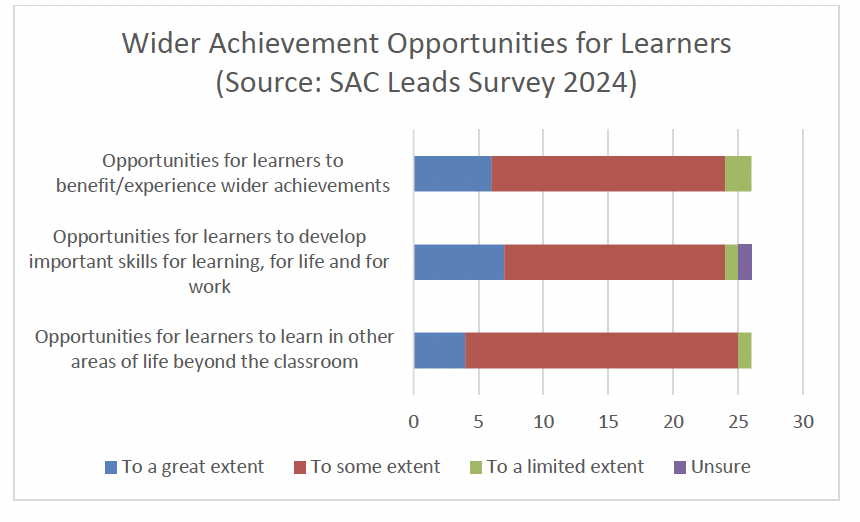
Local authority respondents to the SAC Leads Survey were broadly very positive about ASF supporting a culture and ethos based on educational equity on leadership, professional learning and on learning and teaching practices in the classroom. This is illustrated in Figure 8 below.
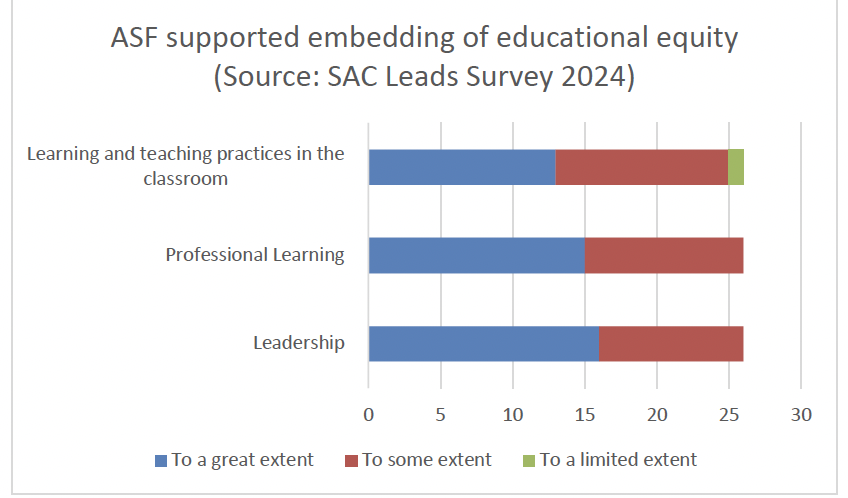
Additionally, ASF was viewed by local authority respondents as supporting embedding of educational equity primarily at school and local authority settings, and to a lesser extent at national, regional and community settings.
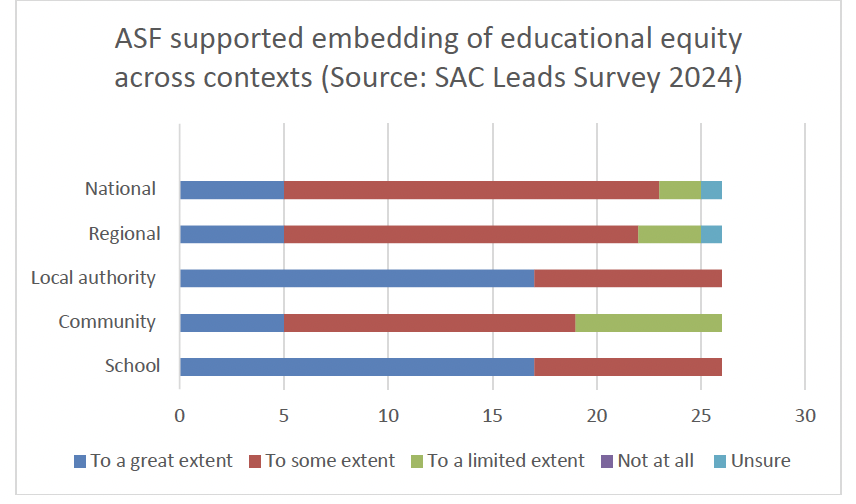
Views of national stakeholders were broadly supportive of this positive assessment in relation to culture and ethos, with funding viewed as ‘focusing minds’ on the poverty-related attainment gap.
Contact
Email: socialresearch@gov.scot
There is a problem
Thanks for your feedback